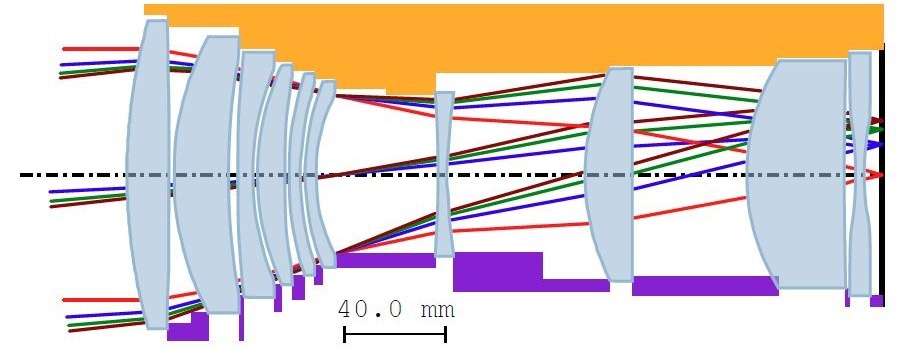Temperature changes must not have an impact on the optical performance of cameras operated in challenging conditions. According to a recent study, determining the precise lens mounting structure to be utilized is an important step in making sure that lens systems are resistant to temperature fluctuations.

Layout of the 10-element lens with a cross-section of the mounting structure in a seatbased mounting structure (orange, top). The seats are on the right surfaces of the first 6 elements and on the left surfaces of the last four elements. A cross-section of the spacer model schematic is also shown (purple, bottom). Image Credit: OPTICA
The new study will be presented at the Optica Design and Fabrication Conference, which will be held in Quebec City, Canada, from June 4–8, 2023, by Eric M. Schiesser of Synopsys Inc.
The researchers stated, “Most optical systems—from the camera in your smartphone to the eyes of the Mars rover—are used over a range of temperatures. To keep the image sharp over the changing temperature, optical engineers can fine-tune the details of the optical and mechanical designs so that the thermal effects balance each other.”
They further added, “Everyone involved in the manufacture of these passively athermalized optical systems should appreciate how interwoven the mounting structure is to the optical prescription, which is the thrust of our design study.”
When temperatures rise or fall, optical systems could lose focus because the glass used to produce lenses and the materials used to build the mounts that hold lenses are sensitive to temperature fluctuations.
However, a technique known as athermalization, which produces optothermal stability by combining several materials with various thermal characteristics, can be used to lessen fluctuations in optical performance across a wide temperature range.
The researchers’ recent work concentrated on passive athermalization as a means of reducing thermal effects. This required constructing the lens system and mounting structure so that the mechanical and thermal shifts of the focal plane array utilized as the camera's detector matched.
They carried out athermalization for the same camera lens using two alternative lens mount structures to demonstrate how crucial it is to take lens mounting features into account. The thermal behavior of a seat model, in which the lenses are supported by seats built into the mounting framework or housing, was initially examined.
Since the mounting structure itself serves as the link between the seats in this instance, the position of any one element is unaffected by the thermal expansion of any other part.
By altering the surface shapes, element thicknesses, lens separations, and lens materials, the researchers athermalized the seat model lens throughout a specified temperature range. They then re-analyzed it using a mounting technique based on spacers.
A stack of lenses and spacers makes up the lens system in a spacer-based housing concept. Glass will not expand as much as most spacer materials for a given temperature rise; hence, the effect of the spacer expansion will be higher than that of the lens expansion.
The focal plane array drifted away from the ideal image plane when the mounting technique was altered, according to a performance comparison for the various lens mount configurations, since lens elements do not respond to temperature changes in the same manner.
The researchers point out that a spacer-based mounting arrangement is not always to blame for this performance degradation. Switching to seats might worsen the performance if the initial athermalization was done assuming spacers.
Overall, the study demonstrates the significance of taking into account the specific mounting structure utilized while doing passive athermalization and the likelihood that modifying the mounting parameters after athermalization would result in poor thermal stability.